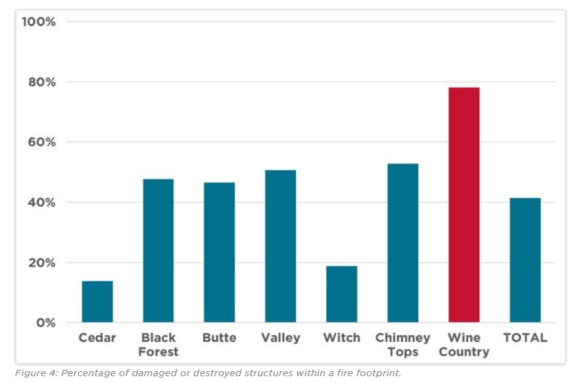Insured losses from the siege of California wildfires could possibly reach $8 billion, according to new estimates released on Friday by catastrophe modeler RMS.
The firm now estimates the insured loss for the wildfires impacting Sonoma, Napa, Solano, Lake and Mendocino counties will reach between $6 billion and $8 billion.
RMS earlier this month estimated losses would range from $3 billion to $6 billion. At that point the fires had destroyed a reported 3,500 structures.
CAL Fire currently estimates 8,800 properties were destroyed, and a high number of those were high priced and insured, according to RMS.
The proportion of properties affected in the burned areas exceeds the typical 15 to 50 percent that are burned in the area of a wildfire footprint, according to Kevin Van Leer, a senior product manager RMS.
He said nearly 75 percent of the properties in the fire areas were affected, and that the increased losses were the result of flying embers driven by the extreme Diablo winds that sent them into areas where fire risk was considered lower. Winds reached speeds of up to 70 mph during the fires.
“What we believe is the likely cause is the ember risk,” Van Leer said. “What we see is a lot of affected neighborhoods were outside the significant burnable fuel zones.”

Heather Williams, a spokeswoman for CAL Fire, said that even concrete structures such as K-Mart, which was surrounded by a large asphalt parking lot, were at the mercy of embers raining down from above. It was one of many commercial properties being counted among the losses.
“It was definitely ember-driven when it came to the destruction level that we saw,” Williams said.
The Tubbs fire was the most damaging of the blazes, and is now considered the most destructive fire in state history, having destroyed 5,400 structures. It far exceeded the damage done by the 1991 Oakland Hills fire, which was California’s most damaging fire after having destroyed 2,900 structures.
The number of individual fires at the peak of the wildfire siege that started in early October reached 21, many of which were large and destructive. The Nuns fire destroyed 1,300 structures, and the Atlas destroyed 930 structures. CAL Fire reports 42 people died from the fires.
Four active fires from the original blazes remain burning. The Tubbs, Pocket and Nuns fires are 95 percent contained, and the Atlas fire is 98 percent contained.
CAL Fire reports more than 2,300 personnel continue to work the fires.
The RMS range of loss includes losses due to property damage, contents and business interruption caused by the fires to residential, commercial and industrial lines of business. Automobile or agricultural crop losses are not included in the RMS estimates.
RMS latest estimate could continue to rise as losses to wineries are increasingly examined.
“We do know that it is a significant source of uncertainty how much the wine industry will be impacted,” Van Leer said.
It may be a while before the magnitude of the impact on business interruption, tourism and the severity of smoke damage on the vintage will be known.
“It’s going to take us several months to see what the economics of it are,” Van Leer said.
Related:
- California’s Wine Industry Taking Stock of Losses After Wildfires
- Northern California Wildfires: Insurance Industry Ready to Assist With ‘Massive’ Recovery
- Early Data Shows Insured Losses from California Wildfires Already at $1B and Growing
- All Wildfire Damage to California Wineries May Not be Covered by Insurance
- Losses from California Wildfires Could Reach up to $6 Billion, Experts Say
- California Wildfires Are a ‘Larger Scale Disaster’
Topics Catastrophe Trends Natural Disasters California Profit Loss Wildfire
Was this article valuable?
Here are more articles you may enjoy.


 Billionaire NFL Owner Suing Over Billboards Near His LA Stadium
Billionaire NFL Owner Suing Over Billboards Near His LA Stadium  MAPFRE Accuses AAA of Violating Long-Time Exclusive Marketing Agreement
MAPFRE Accuses AAA of Violating Long-Time Exclusive Marketing Agreement  Adjusters Launch ‘CarFax for Insurance Claims’ to Vet Carriers’ Damage Estimates
Adjusters Launch ‘CarFax for Insurance Claims’ to Vet Carriers’ Damage Estimates  Supreme Court Rejects Challenge to $2.46B Boy Scouts Sex Abuse Settlement
Supreme Court Rejects Challenge to $2.46B Boy Scouts Sex Abuse Settlement 

